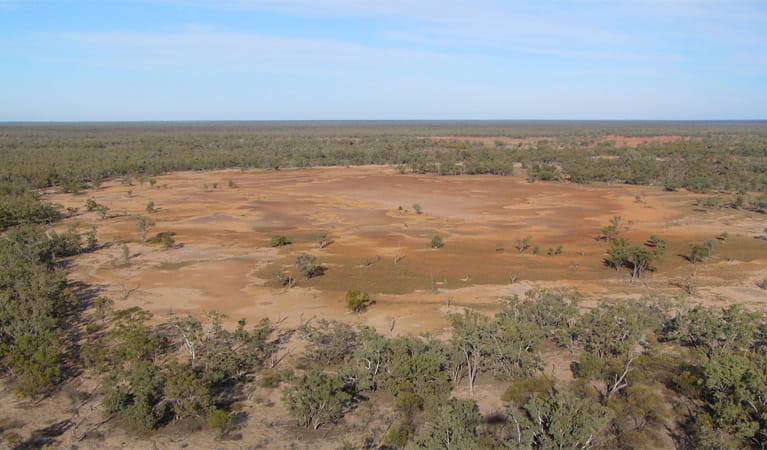Culgoa National Park
Overview
Culgoa is a remote national park offering scenic views, camping, birdwatching, picnicking, and a number of enjoyable day walks through the varied landscape.
Read more about Culgoa National Park
Some landscapes are iconic, like a scenic view ready-made for a postcard, or something out of legend. Culgoa is outback colours: ochre and brown and yellow, scorched by the sun. It’s also majestic river red gums and wide grassy floodplains, with wildflowers blooming after the wet season. And it’s the coolabah tree, a native species made famous by the bush ballad Waltzing Matilda. Indeed, Culgoa has more coolabah woodland than any other national park in NSW. In other words, it’s the sort of scene evoked in the popular idea of the Australian outback, filled with billabongs and buzzing rivers and croaking cicadas in dry leaves.
Visitors to Culgoa will find a fascinating park filled with Aboriginal history and the legacy of colonial pastoralists who once worked the land. And there’s plenty to do, too, from fishing in the river after the rains to birdwatching and spotting nocturnal animals – brushtail possums and little pied bats, for example, are most active at night. Self-sufficient campers will find a quiet retreat and day-trippers will find places to picnic near Brigalow-gidgee woodland. This is also a wonderful place for hiking, particularly in the cooler months. Culgoa offers a variety of day walks to appeal to all experience and fitness levels.
But perhaps the biggest draw is simply the solitude. Coming to Culgoa means getting away from everything else, and getting back to nature. Right on the edge of NSW, in many ways Culgoa gets to the heart of what makes national parks special in the first place.
Local alerts
For the latest updates on fires, closures and other alerts in this area, see https://www.nationalparks.nsw.gov.au/visit-a-park/parks/culgoa-national-park/local-alerts
Contact
- in the Outback NSW region
Culgoa National Park is always open, but may have to close at times due to poor weather or fire danger.
-
-
Bourke office
02 6830 0200
Contact hours: Monday to Friday, 8.30am to 4.30pm. - 51-53 Oxley Street, Bourke NSW 2840
-
Email: npws.bourke@environment.nsw.gov.au
-
Bourke office
Visitor info
All the practical information you need to know about Culgoa National Park.
Map
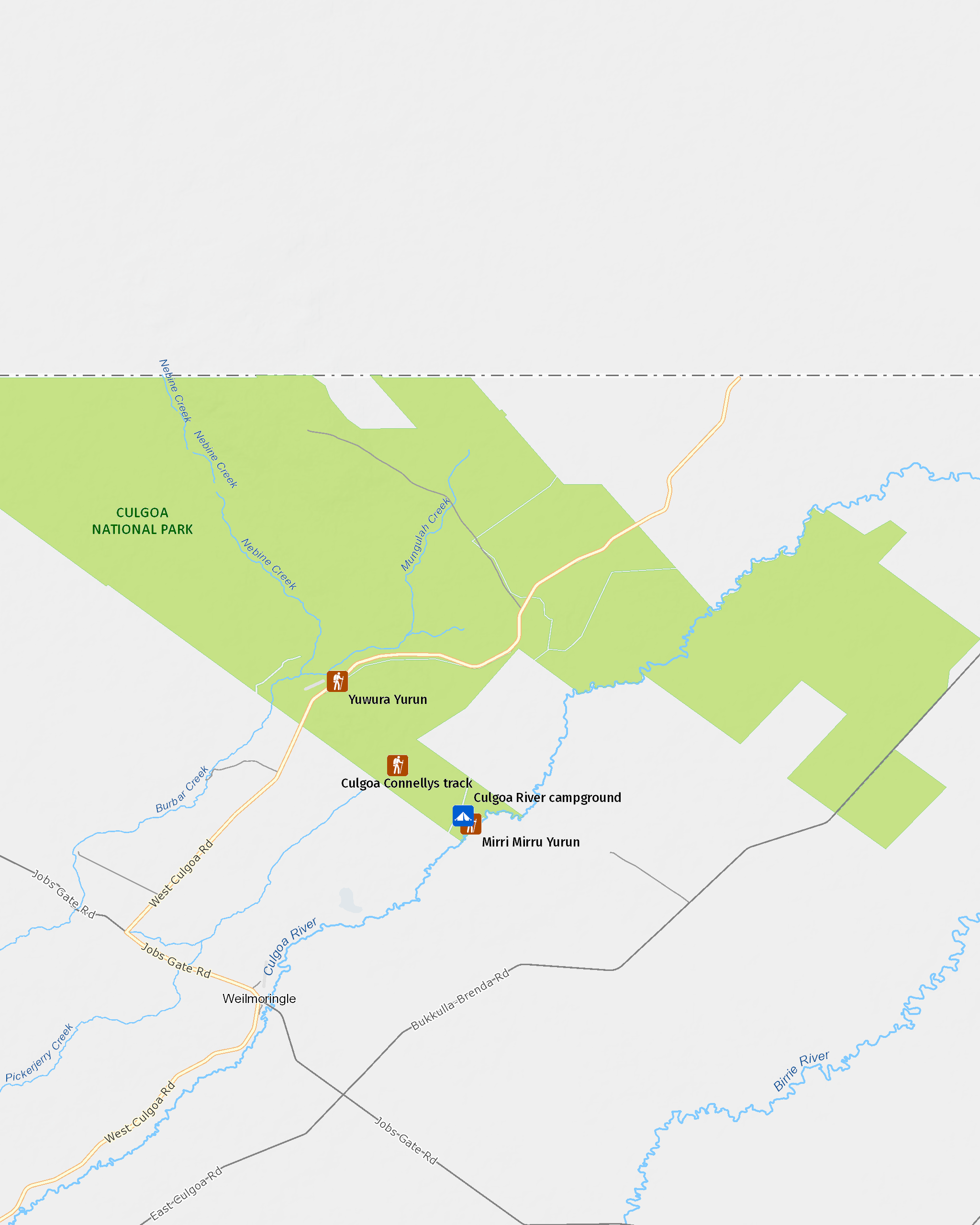
Map legend

Getting there and parking
Get driving directions
From Bourke:
- One route follows the dirt River Road to Weilmoringle, where you turn left onto Enngonia Road. This is approximately 180km.
- A sealed road option via Brewarrina is approximately 220km, though the last 20km from Weilmoringle is unsealed
Parking
- Culgoa River campground See on map
By bike
Check out the Bicycle information for NSW website for more information.
By public transport
For information about public transport options, visit the NSW country transport info website
Best times to visit
There are lots of great things waiting for you in Culgoa National Park. Here are some of the highlights.
Spring
After reasonable winter rains, the park erupts with blooms of native wildflowers, and animals begin to raise their young.
Summer
Summer in Culgoa can be incredibly hot, so hiking should be attempted by experienced walkers only. For everybody else, this is a perfect opportunity to take advantage of the coolness of Culgoa River.
Winter
This is a great time to settle in at Culgoa River campground, with winter the best time for walking in the park. Wildlife is still abundant and birdwatching is superb.
Weather, temperature and rainfall
Summer temperature
Average
21°C and 34.9°C
Highest recorded
46.4°C
Winter temperature
Average
5.7°C and 19.6°C
Lowest recorded
-3.3°C
Rainfall
Wettest month
January
Driest month
August
The area’s highest recorded rainfall in one day
207.1mm
Facilities
Maps and downloads
Prohibited
Pets
Pets and domestic animals (other than certified assistance animals) are not permitted. Find out which regional parks allow dog walking and see the pets in parks policy for more information.
Smoking
NSW national parks are no smoking areas.
Nearby towns
Brewarrina (119 km)
Stone fisheries were built on the bed of the Darling River (just downstream from the present day weir) - you can still see them today on a guided tour.
Bourke (217 km)
Around 50km north of Gundabooka National Park is the town of Bourke. Considered the "Gateway to the real outback", Bourke is home to around 3,000 people and has a range of places to eat, garages and services, and plenty of things to do.
Nyngan (328 km)
Explorer Thomas Mitchell camped at the site of the present-day town of Nyngan in 1835; the town site was surveyed in 1882. Wander the self-guided heritage trail to see many fine examples of buildings from this era.
Learn more
Culgoa National Park is a special place. Here are just some of the reasons why:
Rich cultural life
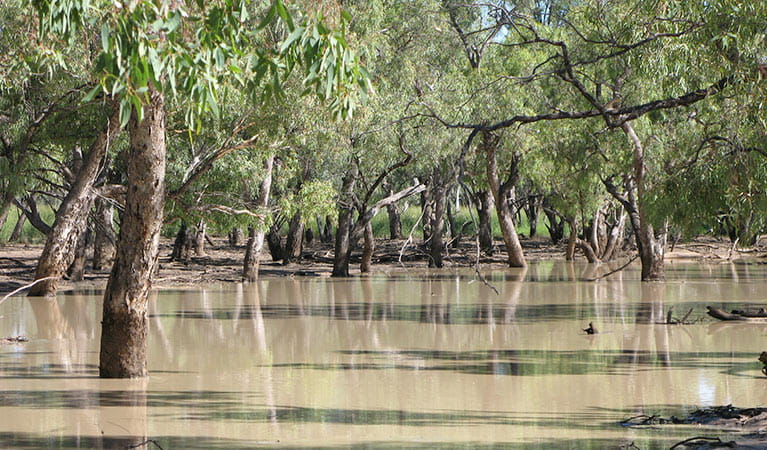
Aboriginal Australians have a long relationship with Culgoa. Murrawarri people, from the Gandugari group, consider it traditional land and it has significant archaeological and cultural value. Other tribal groups include the Ngemba, Ngaampaa, Paakandji, Morawari and Budjiti, who work with the NPWS in discussions of land management. Today, Murrawarri descendants reside in the area around the park, including the townships of Weilmoringle, Brewarrina, Goodooga, Bourke and Enngonia. These people retain a strong oral history of the region, expressed as traditional knowledge, beliefs, personal history and attachment to the landscape.
Under the shade of a coolabah tree
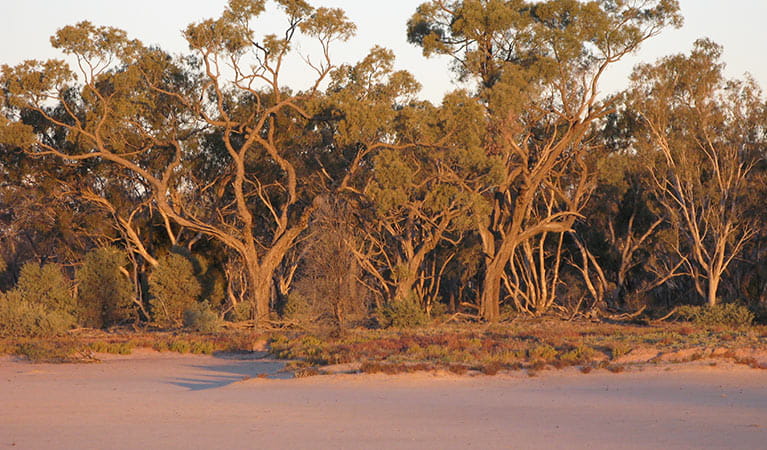
Culgoa is the only national park in NSW with Brigalow-gidgee woodland. It also has the largest continuous tract of coolabah woodland left in the state, meaning plenty of opportunities to settle down in the afternoon 'under the shade of a coolabah tree'.
- Culgoa Connellys track Culgoa Connellys track is an easy 8km return trail through open coolabah woodlands, with plenty of animals to see and opportunities for birdwatching and astronomy.
- Mirri Mirru Yurun Mirri Mirru Yurun (River Bank walk) is an easy 1km walk along Culgoa River, with opportunities for wildlife viewing and a place to stop for a barbecue afterwards.
Iconic plants and animals
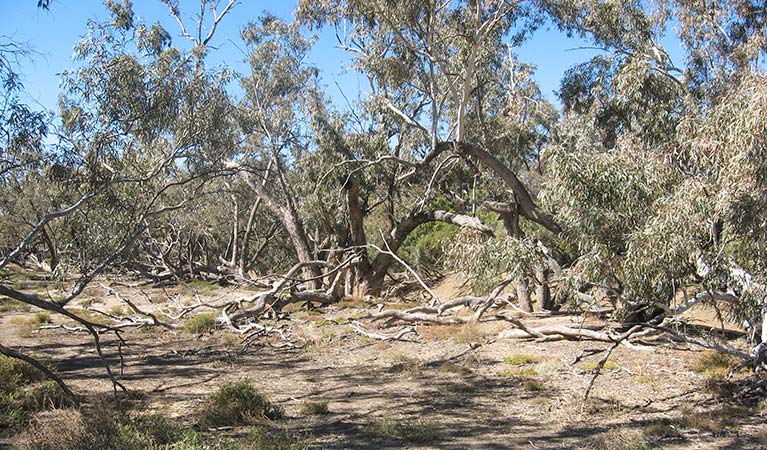
Culgoa has enough animals to keep even the most knowledgable naturalist glued to their binoculars: 24 mammals, 170 species of bird, 29 lizards, seven types of snake, and 15 types of frog. If you're lucky, you might spot a long-necked tortoise - there are many varieties in the park. Even more special, Culgoa has one of the largest koala populations in northern NSW.
- Culgoa Connellys track Culgoa Connellys track is an easy 8km return trail through open coolabah woodlands, with plenty of animals to see and opportunities for birdwatching and astronomy.
- Yuwura Yurun Yuwura Yarun (Sandhill track) offers the most comprehensive walk in Culgoa National Park, crossing diverse habitats and offering birdwatching and picnicking opportunities.
Historic heritage
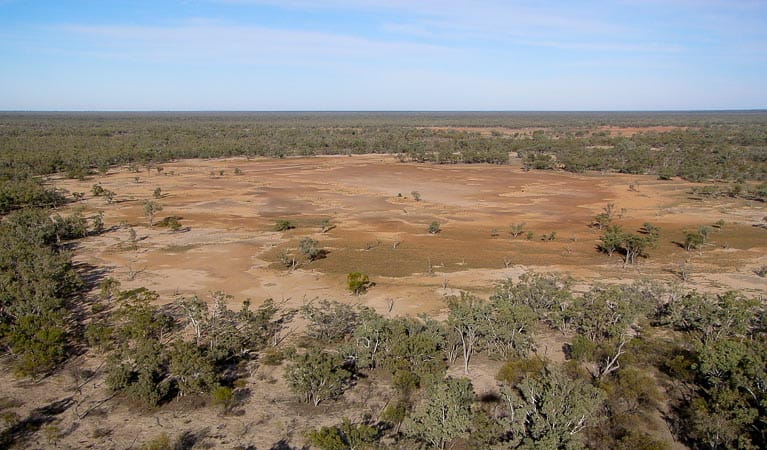
Charles Sturt was the first European explorer to venture here, in 1829, but colonial pastoralists were not far behind. By the 1860s, settlements were established right across the region, with large properties like Byerawering, Cawwell and Burban Grange, where Culgoa River campground can be found today. Culgoa National Park is committed to conserving the pastoral history of the area.
Education resources (1)
What we're doing
Culgoa National Park has management strategies in place to protect and conserve the values of this park. Visit the OEH website for detailed park and fire management documents.

